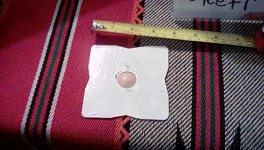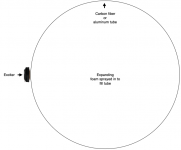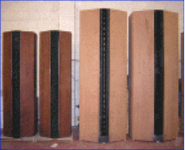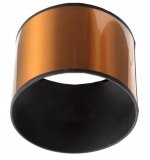in traditional systems the weight is one of the main problems, partly solved by the array lines, but we are always talking about 50-60 kg, while in the old traditional trapezoidal systems it was much more than 100 kg, with a system of this kind that in fact has a cabinet or in practice a real box does not make any difference a few grams more or less if you use carbon or maybe wood, the difference is only the fact that carbon, being very rigid, should allow the vibrations applied and avoid the problems related to the resonances of other less rigid materials. But I would like to launch a proposal, since some of you may be competent in the use of carbon processing why don't we join forces and pay the costs to make prototypes? we could essentially pay the expenses ourselves and someone capable would make them, he would be left with the panels and we would have the opportunity to understand many things by spending very little if we are at least 3-4 people or even more. We could create a group that decides how to proceed, shorten the time and increase the experience on this kind of product.
Last edited:
Mpte.
Good threads,thanks.
These types of materials could be ideal for my small panels.
Before the lockdown at the last audio show I went to,there were similar cone materials being shown.
I was very tempted to walk out with one of the samples!!
But honesty prevailed😀
It would be great to mould a single panel with a dome in the centre,like the one in this picture,not this shape but a little larger probably.
I have only read the first article so far as I got a little distracted with the other articles at the bottom of the page.
Mainly this one using so-called race track drivers?
A New Standard of Low-Depth Racetrack Speaker Drivers with Flat Core Speaker Technology | audioXpress
I have thought of using this type of coil shape to allow just a thin strip to mount to the panel.
You may have noticed I'm not keen on circular coils and the inherent problems they cause,this I feel should negate most of ,if not all of these problems?
Obviously piezoelectric drivers are another option?
But the dome does a good job of sorting out most of the coil and cavity problems, so I'm happy at the moment ,with the thin card and dome arrangement .
But thicker panels are a harder problem to fix with a dome?
Steve.
Good threads,thanks.
These types of materials could be ideal for my small panels.
Before the lockdown at the last audio show I went to,there were similar cone materials being shown.
I was very tempted to walk out with one of the samples!!
But honesty prevailed😀
It would be great to mould a single panel with a dome in the centre,like the one in this picture,not this shape but a little larger probably.
I have only read the first article so far as I got a little distracted with the other articles at the bottom of the page.
Mainly this one using so-called race track drivers?
A New Standard of Low-Depth Racetrack Speaker Drivers with Flat Core Speaker Technology | audioXpress
I have thought of using this type of coil shape to allow just a thin strip to mount to the panel.
You may have noticed I'm not keen on circular coils and the inherent problems they cause,this I feel should negate most of ,if not all of these problems?
Obviously piezoelectric drivers are another option?
But the dome does a good job of sorting out most of the coil and cavity problems, so I'm happy at the moment ,with the thin card and dome arrangement .
But thicker panels are a harder problem to fix with a dome?
Steve.
Attachments
Did someone say "spreadtow"?
Eric
Attachments
Eric -- Nice!
Update
I've determined that the support system I currently use for my panels has significant resonances with certain music.
While I have identified/measured the specific resonant frequencies, I suspect that the 2.8k to maybe 3k messiness Steve heard:
might have something to do with this.
In any case, I've decided to address the resonance everywhere I think I can.
I've started filling the vertical main supports (essentially an aluminum tube) with foam. Big difference in just trying to "ring" them with a knock (which has me wondering about something else I'll post later).
I'll next look add adding either insulation or points at the two bottom supports for each panel as well as something similar at the top supports.
I'll isolate the amplifiers, which currently just sit on the aluminum/wood bases and then check the lamination of the bases.
Just details, I hadn't gotten to do yet.
More to come.
Update
I've determined that the support system I currently use for my panels has significant resonances with certain music.
While I have identified/measured the specific resonant frequencies, I suspect that the 2.8k to maybe 3k messiness Steve heard:
I first noticed the the harsh sound on my headphones,first on the computer,then my phone,and then on my tablet,I also listened on 3 different headphones just to be sure.
I originally thought the frequency was higher up,so was surprised when it was 2.8k to maybe 3k?
The second higher pitched voice in the recording seems to set it off,I was playing it quite loudly at the time,but once noticed it was hard to ignore.
might have something to do with this.
In any case, I've decided to address the resonance everywhere I think I can.
I've started filling the vertical main supports (essentially an aluminum tube) with foam. Big difference in just trying to "ring" them with a knock (which has me wondering about something else I'll post later).
I'll next look add adding either insulation or points at the two bottom supports for each panel as well as something similar at the top supports.
I'll isolate the amplifiers, which currently just sit on the aluminum/wood bases and then check the lamination of the bases.
Just details, I hadn't gotten to do yet.
More to come.
Why not a tube?
I came across large diameter carbon fiber tubes at Dragon Plate.
One can also find such tubes in aluminum.
Consider, bending a DML panel into a long tube as in the attached.
Fill the tube with foam to further "stiffen" the tube.
One would need t come up with a clever way to mount the exciter.
Wouldn't this give one a highly rigid, very light, and omni-directional DML?
Thoughts?
I came across large diameter carbon fiber tubes at Dragon Plate.
One can also find such tubes in aluminum.
Consider, bending a DML panel into a long tube as in the attached.
Fill the tube with foam to further "stiffen" the tube.
One would need t come up with a clever way to mount the exciter.
Wouldn't this give one a highly rigid, very light, and omni-directional DML?
Thoughts?
Attachments
In his The Development of Beveridge Speakers the electrostatic speakers designed by his father, Harold, Rick Beveridge has the following interesting paragraph:
I had a personal experience of such a setup at New York's Stereo Exchange (maybe in the late 1980's, but I could have the years wrong). I knew the owner, Dave Wasserman. Stereo Exchange dealt in new and used equipment, so lots of verying interesting pieces passed through that shop.
On occasion a group of audiophiles would gather after hours to listen to new and used equipment that had come into the shop. This gave all of us chance to listen to equipment and ideas about equipment, many of us (in our younger years) could never afford to own at the time.
One evening, we listened to, what I remember as, a pair of Beveridge X1s or Model 2s (see attached photo, I remember them as very tall) set up to the left and right of the seating area, on the same axis as the listeners ears (90 degrees off what the listener faced) similar to what Rick Beveridge describes in the above quote. One can almost picture this placement as earphones for an entire room.
I remember the speakers sounding amazing - the best sound I had ever heard reproduced at that point (later in the evening someone set up a subwoofer in the middle of the room and we took turns sitting on it while listening to the then top end Stax electrostatic headphones, pretty darn good that too). We had a lot of fun in those days.
The 180 degree dispersion patterns of the Beveridge speakers enabled such an unusual placement.
Seems like DML's would as well.
I don't suggest that DML's would perform better in such a position, rather that DML's might give us far more placement options than conventional speakers.
Because these new speakers were true line sources with a 180 degree dispersion patterns, their placement in our home was novel. Our living room at that time was about twenty feet wide by fifty feet long. There was a large circular fireplace on the centerline and about twenty feet from one end. Each speaker was placed with its back to a long wall, facing the fireplace and the other speaker. The highs, mid-range, and lows were dispersed uniformly throughout the entire room. There were no more "bright" and "dull" spots.
I had a personal experience of such a setup at New York's Stereo Exchange (maybe in the late 1980's, but I could have the years wrong). I knew the owner, Dave Wasserman. Stereo Exchange dealt in new and used equipment, so lots of verying interesting pieces passed through that shop.
On occasion a group of audiophiles would gather after hours to listen to new and used equipment that had come into the shop. This gave all of us chance to listen to equipment and ideas about equipment, many of us (in our younger years) could never afford to own at the time.
One evening, we listened to, what I remember as, a pair of Beveridge X1s or Model 2s (see attached photo, I remember them as very tall) set up to the left and right of the seating area, on the same axis as the listeners ears (90 degrees off what the listener faced) similar to what Rick Beveridge describes in the above quote. One can almost picture this placement as earphones for an entire room.
I remember the speakers sounding amazing - the best sound I had ever heard reproduced at that point (later in the evening someone set up a subwoofer in the middle of the room and we took turns sitting on it while listening to the then top end Stax electrostatic headphones, pretty darn good that too). We had a lot of fun in those days.
The 180 degree dispersion patterns of the Beveridge speakers enabled such an unusual placement.
Seems like DML's would as well.
I don't suggest that DML's would perform better in such a position, rather that DML's might give us far more placement options than conventional speakers.
Attachments
Last edited:
Why not a tube?
How about a lampshade?
Attachments
chdsl --
Yeah! Why not? Whole different form factor (at least until someone cites the acoustical/physics and dismantles the idea).
How about a lampshade?
Yeah! Why not? Whole different form factor (at least until someone cites the acoustical/physics and dismantles the idea).
aagas.
From what I remember when I made a 12inch sphere ,hoping to produce an omnidirectional speaker ,was that bending waves don't like bending round corners?
Practically all the sound came from a small area on the opposite side of the sphere!!
Steve.
From what I remember when I made a 12inch sphere ,hoping to produce an omnidirectional speaker ,was that bending waves don't like bending round corners?
Practically all the sound came from a small area on the opposite side of the sphere!!
Steve.
Steve -- Well, at least I had the fun of running with the idea for a full 5 or 6 hours.
Next!
Next!
aagas you should check out this linkHHR Exotic Speakers Its based of the Walsh Omni directional exciters
It could be interesting if one had thin CF that could be fabricated into a cone. One could 3D print a thin Al or Ti cone but it be pricey .....
It could be interesting if one had thin CF that could be fabricated into a cone. One could 3D print a thin Al or Ti cone but it be pricey .....
Tagis.
I liked the sound of the Walsh drivers,but wasn't that keen on the implementation,firing into a box.
To me it sounded a little boxy.
Same problem as the manger.
I'd compare it to putting an electrostatic in a box.
The Walsh driver looks pretty simple,but is in fact ,very complicated to design correctly.
The cone is designed to buckle and bend in a precise manner under pressure from the coil.
Not an easy task.
What would it have sounded like without the box?
Steve.
I liked the sound of the Walsh drivers,but wasn't that keen on the implementation,firing into a box.
To me it sounded a little boxy.
Same problem as the manger.
I'd compare it to putting an electrostatic in a box.
The Walsh driver looks pretty simple,but is in fact ,very complicated to design correctly.
The cone is designed to buckle and bend in a precise manner under pressure from the coil.
Not an easy task.
What would it have sounded like without the box?
Steve.
Acoustic MetaMaterial Omni Speaker
Here is a samples of music recorded of the Omni-Directional Speakers that are 51cm diameter and are driven by my new drivers design I am getting a paper out that goes in to detail about this in the next few months.
I am posting 2 tunes that Burnt Coil did on his tall Blondes .
This is with a UMK-1 mic recording 2.5 m distance.
I am finishing up Ralph which is a binaural Mic set that is made from a ballistic gel model of my head was from a MRI data scan of my head. One really need a binaural recording to really appreciate the Omni-Directional experience.
Cheers
Steve
Here is a samples of music recorded of the Omni-Directional Speakers that are 51cm diameter and are driven by my new drivers design I am getting a paper out that goes in to detail about this in the next few months.
I am posting 2 tunes that Burnt Coil did on his tall Blondes .
This is with a UMK-1 mic recording 2.5 m distance.
I am finishing up Ralph which is a binaural Mic set that is made from a ballistic gel model of my head was from a MRI data scan of my head. One really need a binaural recording to really appreciate the Omni-Directional experience.
Cheers
Steve
Attachments
Please forgive me for asking such a newbie question but I am just learning about the concept of DMLs and find the subject area quite fascinating. From reading through some parts of this thread I see that I have a LOT to learn.
For my TV setup, I have a set of Boston Acoustics 5.1 speakers that are of okay quality. I mean they're certainly not high end but they're not terrible either. Just okay. The problem I have is that my TV room is of limited size so the viewing couch is pushed right up to within 1 - 2 inches from the back wall which doesn't allow me to place the rear channel speakers behind the viewing position. They are 12" x 7.5" x 9" (H x W X D) 2-way bookshelf speakers so the best I can do is place them at opposite ends of the viewing couch facing towards each other and the viewer sits in between them. It works but it's not really where the rear channels are supposed to be in order to give you a proper surround sound experience.
DML speakers interest me because they have almost no depth to them so I could theoretically place a pair of them on or just off the wall above the back of the couch and get the rear channel sound coming from behind my ears rather than off to the sides like it is now. The space above the back of my couch that's available for mounting DMLs is 8 feet wide by 4 feet high but if I used all of that 4 feet of height, the DMLs would be right down to the top of the couch back. The couch back is around 8 inches thick and when I sit in it, the back of my head ends up being about 5" from the back wall. My ears might end up being within a few inches of one of the DML panels if they came down that far and if I wasn't sitting in front of the gap between the two speakers.
So finally to my questions: Would DMLs work OK for my rear channel speakers in this situation? Or is having them placed so close to the back wall (and my ears) going to make them sound like crap?
If they would work okay and given what wall space I have, how many panels for each channel would be good to use and what approximate size(s)?
In my experience, the volume of sound coming through my rear channel speakers is often fairly low. Do DMLs work okay at low volumes or do they need a fair bit of volume before they start to work okay?
If DMLs would work okay in this setting/application then I could look at upgrading to a 7.1 or 7.2 system and using those bookshelf speakers as rear side channels.
For my TV setup, I have a set of Boston Acoustics 5.1 speakers that are of okay quality. I mean they're certainly not high end but they're not terrible either. Just okay. The problem I have is that my TV room is of limited size so the viewing couch is pushed right up to within 1 - 2 inches from the back wall which doesn't allow me to place the rear channel speakers behind the viewing position. They are 12" x 7.5" x 9" (H x W X D) 2-way bookshelf speakers so the best I can do is place them at opposite ends of the viewing couch facing towards each other and the viewer sits in between them. It works but it's not really where the rear channels are supposed to be in order to give you a proper surround sound experience.
DML speakers interest me because they have almost no depth to them so I could theoretically place a pair of them on or just off the wall above the back of the couch and get the rear channel sound coming from behind my ears rather than off to the sides like it is now. The space above the back of my couch that's available for mounting DMLs is 8 feet wide by 4 feet high but if I used all of that 4 feet of height, the DMLs would be right down to the top of the couch back. The couch back is around 8 inches thick and when I sit in it, the back of my head ends up being about 5" from the back wall. My ears might end up being within a few inches of one of the DML panels if they came down that far and if I wasn't sitting in front of the gap between the two speakers.
So finally to my questions: Would DMLs work OK for my rear channel speakers in this situation? Or is having them placed so close to the back wall (and my ears) going to make them sound like crap?
If they would work okay and given what wall space I have, how many panels for each channel would be good to use and what approximate size(s)?
In my experience, the volume of sound coming through my rear channel speakers is often fairly low. Do DMLs work okay at low volumes or do they need a fair bit of volume before they start to work okay?
If DMLs would work okay in this setting/application then I could look at upgrading to a 7.1 or 7.2 system and using those bookshelf speakers as rear side channels.
Last edited:
Dangerboy.
Dml would work fine for rear surrounds or main front speakers.
The problem is the closeness of the rear wall.
If you have stud walls you could mount them directly on to the wall?
Depending on what's on the other side of the wall.
Is the rear channel from the amp restricted to say,150hz to something like 10k,or is it full range?
There are a few options you could try,depending on what frequency response is needed.
Steve
Dml would work fine for rear surrounds or main front speakers.
The problem is the closeness of the rear wall.
If you have stud walls you could mount them directly on to the wall?
Depending on what's on the other side of the wall.
Is the rear channel from the amp restricted to say,150hz to something like 10k,or is it full range?
There are a few options you could try,depending on what frequency response is needed.
Steve
- Home
- Loudspeakers
- Full Range
- A Study of DMLs as a Full Range Speaker




